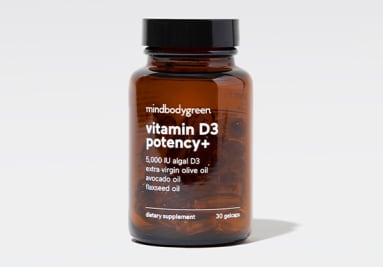
Image by Lyuba Burakova / Stocksy
February 23, 2023
For such a vital nutrient, there’s no shortage of misinformation about vitamin D out there. Seeing as vitamin D deficiency affects 29% of the U.S. population1 (with 41% being insufficient), we believe it’s time to set the record straight—once and for all. Here are five myths about vitamin D we’ve busted so far:
Advertisement
This ad is displayed using third party content and we do not control its accessibility features.
Myth 1: We can get enough vitamin D from food and sunshine.
Although vitamin D is known as the “sunshine vitamin,” it’s simply not possible to get all the vitamin D we need from sunlight while following safe sun exposure practices.
While our skin is able to ultimately convert a limited range of the sun’s UVB rays into vitamin D3 (so cool), there are many factors that affect this process—such as geographical location, season, UV index, climate, pollution, skin tone, and even age. And that’s not even considering how little time we spend outside as a modern society.
So if we’re working an office job and spending most of our time indoors, we should increase the number of vitamin-D-rich foods in our diet, right? In most situations, this is a very logical and effective approach to filling nutrient gaps—but vitamin D sufficiency isn’t so easily achieved.
Unfortunately, even the foods richest in vitamin D don’t provide high enough quantities to meet our daily needs. For example: Trout is the richest food source of vitamin D available and only provides 645 IU of D per 3-ounce serving. Each day, you’d need to eat approximately 23 ounces of trout, 7 cups of irradiated (UV-treated) mushrooms, or 125 slices of cheese to meet 5,000 IU of vitamin D—a dose level tied to vitamin D sufficiency in adults with a normal BMI.
With those absurd quantities, it’s no wonder 93% of Americans2 are failing to get even 400 IU of vitamin D (a bare minimum amount for primitive bone physiology, not whole-body health and thriving) from their food each day. Even milk, one of the most famous and talked about “rich” sources of vitamin D, only delivers 100 IU of the nutrient per cup (because it’s added via fortification). The fact is this: It’s just not realistic to get enough vitamin D from food and sunshine alone.
Advertisement
This ad is displayed using third party content and we do not control its accessibility features.
Myth 2: Vitamin D levels above 30 ng/ml = sufficiency.
If you’ve ever gotten your 25(OH)D blood level tested (the most accurate way to measure your vitamin D status), then you’ve probably seen these ranges of numbers before:
- Anything below 20 ng/ml is considered vitamin D deficiency
- 20 ng/ml to 30 ng/ml is considered vitamin D insufficiency
- Anything above 30 ng/ml is considered “sufficient”
Advertisement
This ad is displayed using third party content and we do not control its accessibility features.
Clinically speaking, these ranges are the standard—and we have a few qualms with that. Trusted nutrition and health experts agree that we need levels at or above 50 ng/ml to provide the vitamin D our bodies need to optimally carry out physiological functions.
The fact is that 30 ng/ml is simply the cutoff for threat of deficiency, not the number you want to aim for. Many health care providers take folks off of their vitamin D supplement once they reach 30 ng/ml. This leads to what mbg’s director of scientific affairs Ashley Jordan Ferira, Ph.D., RDN, calls yo-yoing, or bouncing back and forth between vitamin D insufficiency and sufficiency.
The goal is, and always will be, achieving sufficient levels of vitamin D, and health experts agree: 50 ng/ml is the new gold standard.
Myth 3: 1,000 IU of daily vitamin D is enough to achieve sufficiency.
While 1,000 IU of vitamin D a day might seem like a large quantity, if the goal is achieving and maintaining vitamin D sufficiency, this dose is sub-efficacious when compared to higher potency dosages like 5,000 IU and 10,000 IU. And if your current vitamin D status is below 30 ng/ml, a low dose like 1,000 IU simply isn’t enough to get your levels above 30 ng/ml, much less in the winning range of around 50 ng/ml. (Ferira previously explained the vitamin D math here.)
Research published by the Clinical Journal of the American Society of Nephrology3 reporting on the important research by the late vitamin D advocate and bone health expert Robert P. Heaney, M.D.,4 demonstrates that taking 1,000 IU daily (of D3, not D2, which is less potent) will only raise 25(OH)D levels approximately 10 ng/ml. This simply isn’t enough if you’re dealing with vitamin D insufficiency or deficiency—or trying to maintain vitamin D sufficiency, for that matter.*
Indeed, a high-potency vitamin D supplement of 5,000 IU per day is ideal for most people; or doubling up may be necessary, as individuals may require more or less depending on their unique biology, body composition, and health considerations.
Realistically speaking, if you’re looking to raise your 25(OH)D levels at or above 50 ng/ml to be squarely vitamin D sufficient, anything lower than 3,000 IU of vitamin D3 daily is not likely to get you there—per the science.
Advertisement
This ad is displayed using third party content and we do not control its accessibility features.
Myth 4: Vitamin D toxicity is a tangible concern.
While vitamin D toxicity (aka hypervitaminosis D) is possible, actually reaching toxic levels of vitamin D is an absurdly difficult thing to do. Let’s bust this myth, shall we?
As you can see in this 2018 review published in 5Frontiers in Endocrinology5, the Institute of Medicine and the Endocrine Society have both concluded that 25(OH)D concentrations in our blood need to exceed 150 ng/ml to ignite a legitimate concern of vitamin D toxicity. That’s three times higher than the goal for true sufficiency (and it would take some serious effort or an accident to get there)!
With how difficult it can be to reach 50 ng/ml—even at high-potency doses of vitamin D—you’d have to actively attempt to reach toxic levels of D in order to actually end up there.
Myth 5: All vitamin D supplements are created equal.
If you haven’t caught on by now, vitamin D supplementation at the proper dosage is vital to achieving vitamin D sufficiency.* It’s not all about the IU, though—form and function play a massive role in how effective your vitamin D supplement can be.
When it comes to bioavailability, choose vitamin D3 (cholecalciferol) over D2 (ergocalciferol) every time. The efficacy and stability of D3 simply can’t be matched by D2. You may also want to consider the sustainability of your vitamin D3 source. There are plant-origin, organic options now—like the organic vitamin D3 derived from algae in mbg’s vitamin D product.
To further support the absorption and effectiveness of your D3 supplement, make sure you’re taking this fat-soluble micronutrient with a fat source. Or better yet, choose a thoughtfully designed supplement with healthy fats built right in—like mindbodygreen’s vitamin D3 potency+, which includes an organic trio of olive, avocado, and flaxseed oils to aid absorption.* For more supplement reccomendations, check out our vitamin D roundup.
The results are in: Vitamin D supplements are not all created equal.
Advertisement
This ad is displayed using third party content and we do not control its accessibility features.
The takeaway.
There’s a lot of folklore out there about vitamin D. Figuring out best practices can be a little confusing when it comes to getting enough vitamin D, but a high-quality supplement—like mindbodygreen’s vitamin D3 potency+—can help cover all the bases.
Our D3 supplement delivers high-potency doses of vitamin D (5,000 IU, to be exact) from organic algae, with built-in fats (a trio of organic, virgin olive, avocado, and flaxseed oils) for optimal bioavailability and absorption.* All that in just one gelcap per day. This new-school supplement provides everything you need to promote vitamin D sufficiency for life.*
If you are pregnant, breastfeeding, or taking medications, consult with your doctor before starting a supplement routine. It is always optimal to consult with a health care provider when considering what supplements are right for you.


